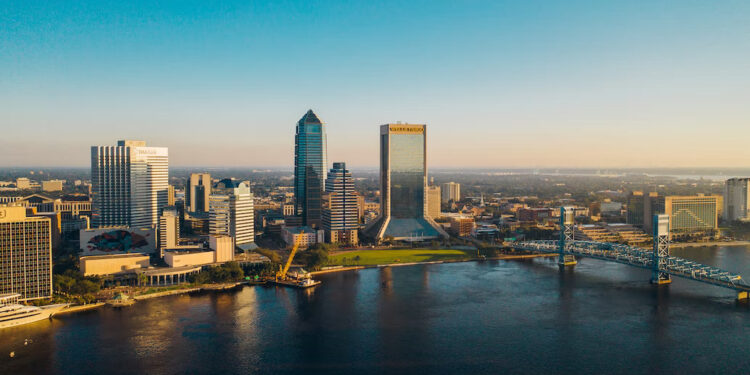Jacksonville’s industrial real estate market finished the year in an advantageous position, despite a handful of slowdowns in the fourth quarter. Over the year, the market experienced double-digit rental growth and record-low vacancy rates.
High tenant demand, high preleasing activity, and limited supply put landlords in a very favorable position to negotiate rent increases with minimal concessions.
General Area Overview & Demographics
Jacksonville is the largest city in the state of Florida, with a population of 987,960 as of 2023.
The median age is 35, and the median household income is $55,531. In addition to being the largest city in the Southeast, Jacksonville is also the largest city by area in the continental US.
Jacksonville has a humid subtropical climate with long, humid summers and mild, short winters. Like most of Florida, Jacksonville can experience severe storms during hurricane season but has not experienced a direct hurricane hit since 1871.
Jacksonville has a large economy with notable activity in banking, finance, distribution, biomedical technology, and manufacturing. It is home to four Fortune 500 companies: CSX, Southeastern Grocers, Fidelity National Financial, and Fidelity National Information Services.
Summary of Jacksonville Industrial Real Estate Performance in Q4 2022
The Jacksonville industrial real estate market showed a stable quarter, posting 604,000 square feet of positive absorption—down from 2 million in Q3 2022 but still higher than historical averages. This quarter’s positive absorption brings yearly absorption to just over 4 million square feet. The Northside and Southside markets were responsible for the majority of quarterly absorption.
Limited industrial supply has also reduced vacancy rates to a historic low of 2.5%, marking the second consecutive quarter of <3% vacancy rates.
The average vacancy rate for warehouse/distribution space was 2.9% and 1.8% for manufacturing. Submarkets with the lowest vacancy rates included Downtown, Northside, and St. Johns at 0.6%, 0.6%, and 1.3%.
What Are Industrial Rates Like in Jacksonville?
The average industrial asking rate in Jacksonville in Q4 2022 was $8.62 per square foot—a 4% increase from $8.27 per square foot in Q3 2022 and $8.25 per square foot in Q2 2022. This quarterly increase represents a record-breaking 18.2% YOY increase. Fierce competition between tenants for limited space has driven strong rental growth.
Average flex asking rates were $11.79 per square foot, while average warehouse asking rates were $7.14 per square foot. The submarkets with the highest asking rates were St. John’s, Southside, and Northside at $9.12, $8.44, and $6.32 per square foot, respectively.
Purchase & Leasing Activity
Leasing velocity has dropped from 2021, though still remains higher than pre-pandemic levels. Less than 10% of new space delivered this year was available for rent by the end of Q4 2022. Sales volume also dropped to under $850 million—down from historic highs of nearly $1.2 billion in Q2 2022.
Despite the drop in sales volume, the average sales price for industrial space increased to a record $95 per square foot. Rising interest rates have caused capital market activity to slow, but activity is expected to pick up again as rates stabilize in 2023.
Notable Industrial Real Estate Deals in Jacksonville in Q4 2022
Despite the lower sales volume, the Jacksonville industrial real estate market posted many notable transactions, including:
- A $6.7 million sale of 47,228 square feet at 5008 Richard Ln;
- Shoreside Logistics’ 290,304 square foot lease at 1 Imeson Park Blvd.;
- Biagi Bros’ 134,700 square foot lease at 460 Ellis Rd N;
- A private $4.5 million sale of 49,272 square feet at 1750 Dobbs Rd; and,
- Priority Tire’s 50,000 square foot lease at 2160 W 33rd St.
Jacksonville’s industrial market has benefited from its lower prices and proximity to major shipping networks.
New Industrial Real Estate Development in Jacksonville in Q4 2022
The Jacksonville industrial real estate market delivered over 1.1 million square feet this quarter, bringing annual additions to a bit under 3 million square feet.
Nearly 7 million square feet of industrial space is in the development pipeline, with nearly 95% of that construction activity in the Northside and Westside submarkets.
Construction has become more difficult over the back half of the year as interest rates have continued to rise. If interest rates stabilize, strong demand will prevent construction delays.
Market Forecast for Jacksonville’s Industrial Real Estate Market in 2023
In spite of the subdued fourth quarter, the Jacksonville industrial real estate market closed out the year strong, breaking several historical growth records. Experts expect activity to remain strong in the future as developers have found ways to manage the increased costs of construction and buying.
Overall, though, Jacksonville has three key factors that will accelerate its growth in 2023: High-quality projects under construction, relatively affordable prices, and planned infrastructural improvements. Jacksonville’s low unemployment rate (2.7%) and rising GDP also indicate a strong job market.
Takeaways for Industrial Real Estate Investors
Jacksonville industrial investors are in a good position and should hold steady with any current investment they have.
Even with the high construction rate, preleasing and leasing activity is strong enough that landlords can negotiate higher rents with tenants who have become accustomed to the post-pandemic landscape.
The only worry for investors is potential construction delays. Rising interest rates and hesitation in capital markets could cause delays, but as long as demand remains high, Jacksonville should weather any choppy waters.
As always, do your research, stay vigilant, and happy investing.












